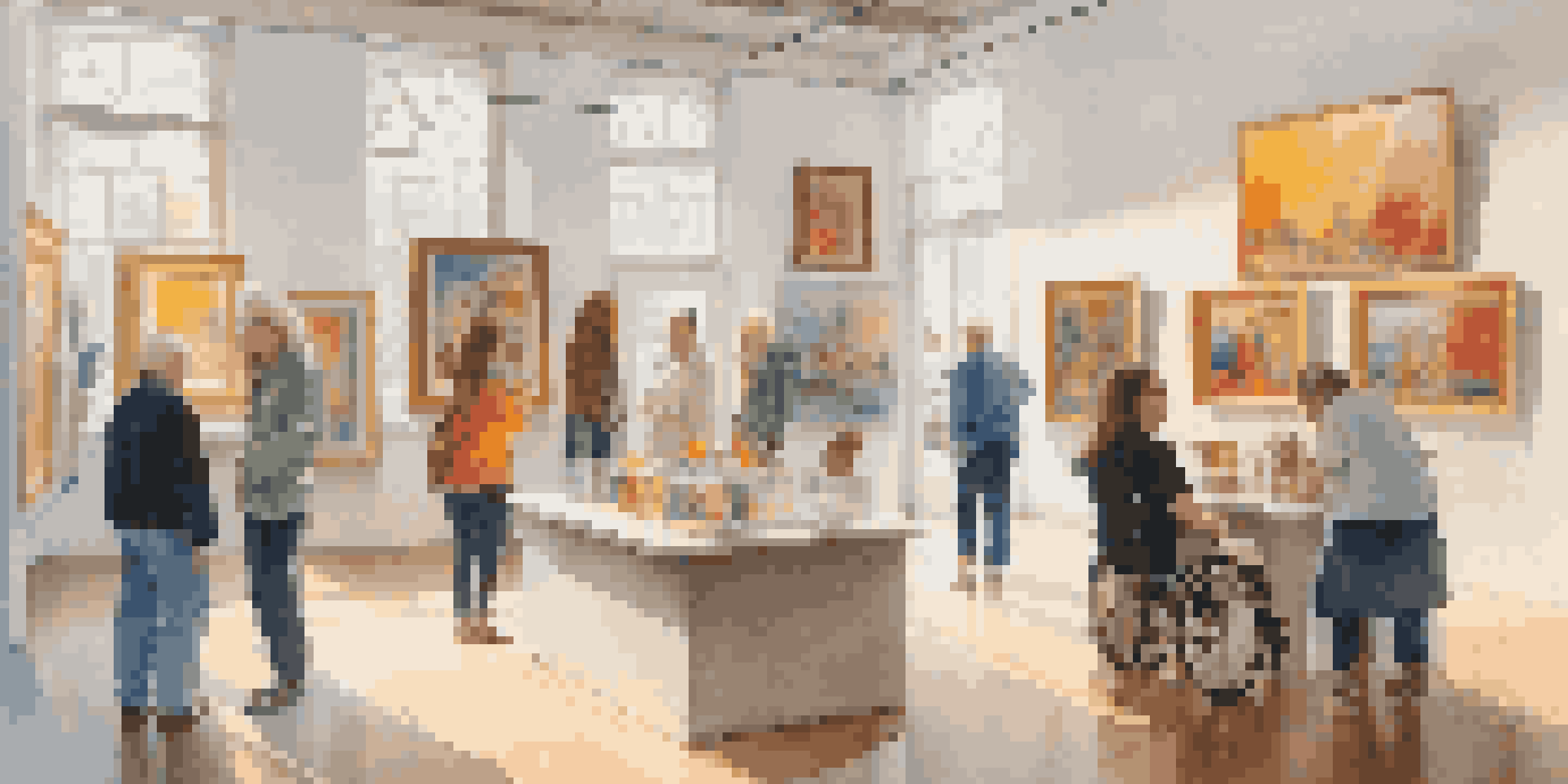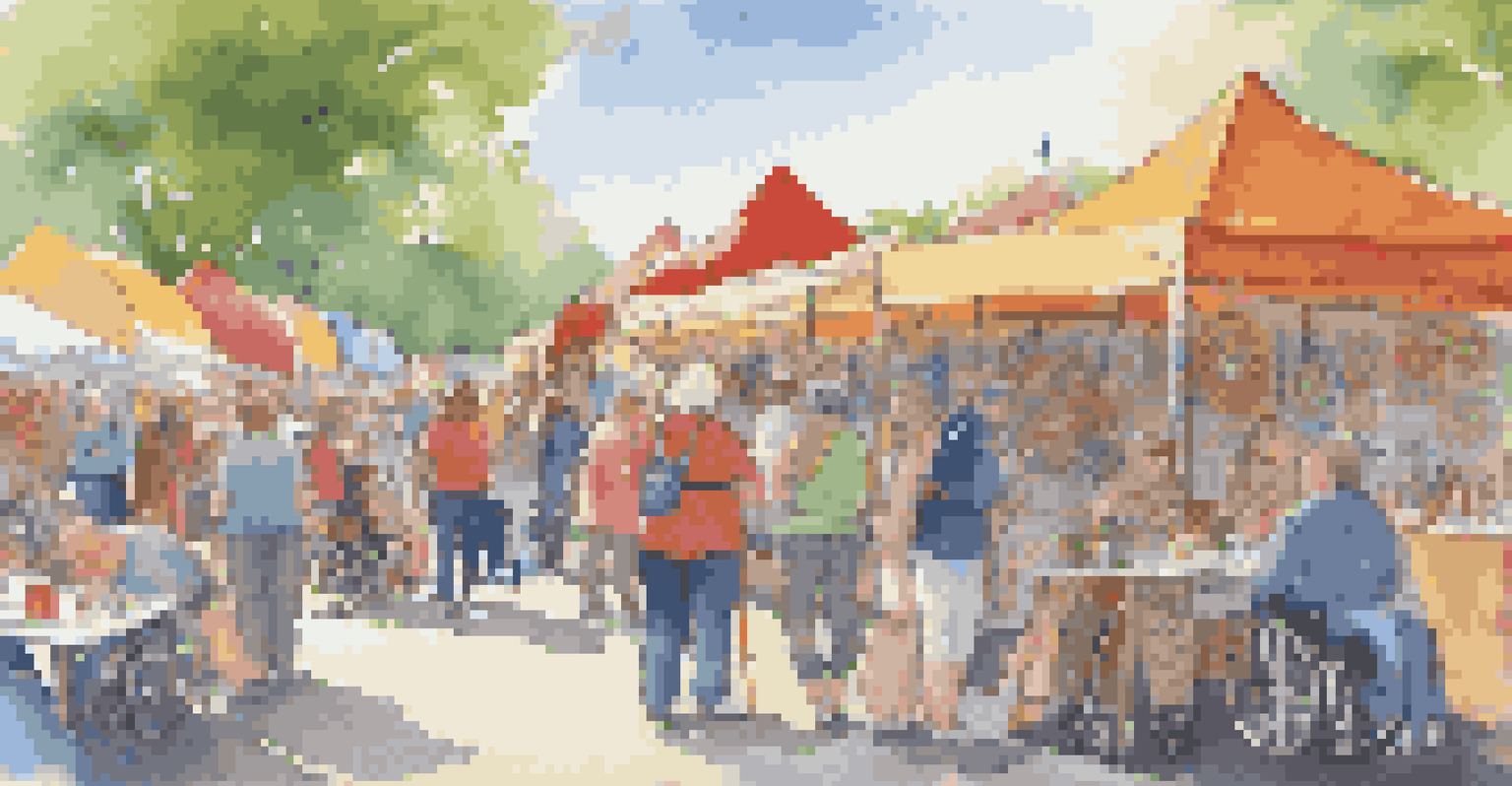Art and Disability: Advocating for Inclusion and Justice

Understanding the Intersection of Art and Disability
Art has always been a powerful medium for expression, and for individuals with disabilities, it can serve as a vital means of communication. By exploring their unique experiences and perspectives, disabled artists can challenge societal norms and stereotypes. This intersection not only highlights the creativity of disabled individuals but also emphasizes the importance of inclusivity in the arts.
Art enables us to find ourselves and lose ourselves at the same time.
In many ways, art becomes a bridge that connects artists with disabilities to broader audiences. It invites people to step into their world, fostering empathy and understanding. This connection can be transformative, reshaping perceptions and advocating for a more inclusive society.
Moreover, the recognition of disabled artists in the art world is crucial for justice and equality. When their work is celebrated, it sends a message that their voices matter and deserve to be heard. This advocacy is an ongoing journey, but each step forward brings us closer to a more equitable representation in the arts.
The Role of Community in Disability Art
Community plays a pivotal role in supporting disabled artists and their work. Local organizations, galleries, and art collectives can provide platforms for showcasing talent and fostering collaboration. These spaces not only nurture creativity but also promote dialogue about disability and representation in art.

When artists come together, they can share resources, experiences, and insights that enrich their creative practices. This collaborative spirit can lead to innovative projects that challenge conventional narratives about disability. In essence, community acts as both a support system and a catalyst for change in the art world.
Art as a Voice for Disabled Artists
Art empowers individuals with disabilities, allowing them to express their unique experiences and challenge societal norms.
Additionally, community engagement helps raise awareness about the barriers faced by disabled artists. By highlighting these challenges, advocates can work towards dismantling systemic obstacles and ensuring that all voices are represented. As we build stronger communities, we pave the way for a more inclusive artistic landscape.
Barriers to Inclusion in the Art World
Despite the progress made, barriers still exist that hinder the full inclusion of disabled artists in the art world. Physical accessibility, funding limitations, and lack of representation in decision-making roles are just a few of the challenges they face. These obstacles can discourage talented individuals from pursuing their artistic ambitions.
The arts are not a luxury; they are a necessity for our well-being.
Moreover, societal attitudes towards disability often influence how artists are perceived and treated within the industry. Stereotypes and misconceptions can lead to marginalization, making it difficult for disabled artists to gain visibility and recognition. This highlights the urgent need for advocates to challenge and change these narratives.
Addressing these barriers requires a concerted effort from all stakeholders in the art community. From policymakers to curators and art enthusiasts, everyone has a role to play in fostering an inclusive environment. By working together, we can create a landscape where disabled artists thrive and contribute their unique perspectives.
Showcasing Disabled Artists and Their Work
One of the most effective ways to advocate for inclusion is by showcasing the work of disabled artists. Exhibitions that highlight their creativity and unique perspectives not only celebrate their talents but also educate the public about the diversity of experiences within the disability community. These showcases can challenge preconceived notions and inspire others to embrace inclusivity.
Additionally, art festivals and events that focus on disability can provide invaluable opportunities for networking and collaboration. These platforms allow disabled artists to connect with peers, curators, and audiences, fostering a sense of belonging and validation. Engaging with the community in this way can amplify their voices and ensure they are heard.
Community Supports Disabled Creatives
Collaboration within communities fosters creativity and raises awareness about the barriers faced by disabled artists.
Furthermore, online platforms have opened new avenues for disabled artists to share their work with a global audience. Social media, in particular, allows artists to connect directly with fans and other creators, breaking down traditional barriers. By leveraging these tools, they can cultivate a supportive network that champions their art and advocacy.
The Power of Storytelling in Disability Art
Storytelling is a crucial element of art, especially for those with disabilities. Through various mediums, artists can convey their lived experiences, struggles, and triumphs in ways that resonate with others. This narrative approach not only fosters empathy but also empowers disabled individuals to reclaim their stories.
Artistic storytelling can take many forms, from visual arts to performance. Each medium allows for different expressions of identity and experience, providing diverse perspectives on disability. This richness in storytelling invites audiences to reflect on their own beliefs and biases, promoting a deeper understanding of the disability experience.
Moreover, when disabled artists share their stories, they contribute to a broader cultural narrative that challenges stereotypes. By centering their voices, they pave the way for future generations of artists to do the same. In this way, storytelling becomes a tool for advocacy, inspiring change and fostering a culture of inclusion.
The Importance of Accessibility in Art Spaces
Accessibility in art spaces is essential for fostering an inclusive environment for disabled artists and audiences alike. This means more than just physical access; it includes providing resources such as sensory-friendly spaces, assistive technologies, and programming that caters to diverse needs. Creating accessible art environments ensures that everyone can engage with and appreciate the work being presented.
When art spaces prioritize accessibility, they send a strong message about their commitment to inclusion. This creates a welcoming atmosphere where disabled individuals feel valued and respected. Moreover, accessible practices can enhance the overall experience for all visitors, promoting a richer engagement with art.
Accessibility is Key to Inclusion
Ensuring accessibility in art spaces is crucial for creating an inclusive environment where everyone can engage with art.
Incorporating feedback from disabled artists and audiences is vital for improving accessibility. By actively involving the community in decision-making processes, art institutions can better understand and address the needs of those they serve. This collaborative approach fosters a culture of inclusivity, making art spaces more equitable for everyone.
Advocacy and Policy Changes for Inclusion
Advocating for inclusion in the arts requires a multifaceted approach, including policy changes at various levels. From local governments to national organizations, effective advocacy can lead to the implementation of policies that promote equal access and representation for disabled artists. These changes are crucial for dismantling systemic barriers that have persisted for too long.
Collaboration among artists, advocates, and policymakers can drive meaningful change. By sharing insights and experiences, stakeholders can work together to develop policies that address the unique challenges faced by disabled artists. This collective effort can amplify their voices and ensure that their needs are prioritized in the decision-making process.

Ultimately, advocacy is about creating a culture of inclusion that values diversity in the arts. By championing policies that support disabled artists, we can foster an environment where creativity knows no bounds. As we push for these changes, we pave the way for a more just and equitable art world.